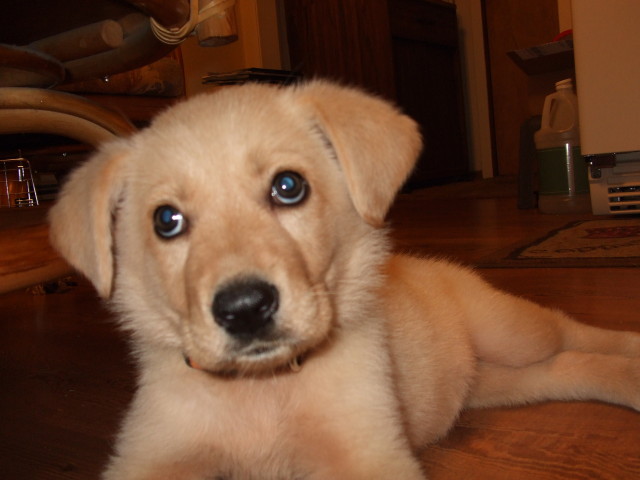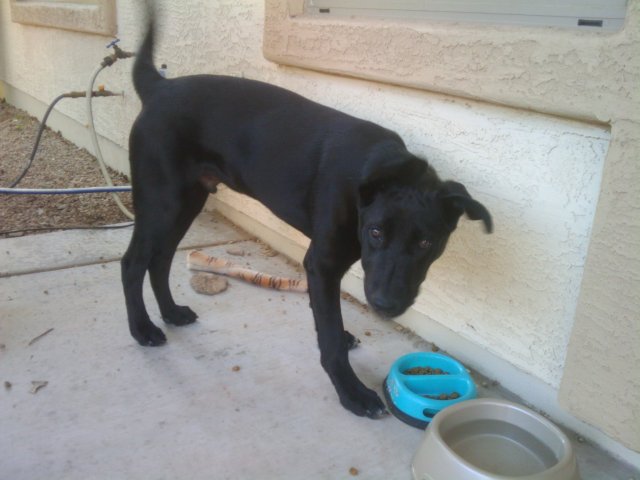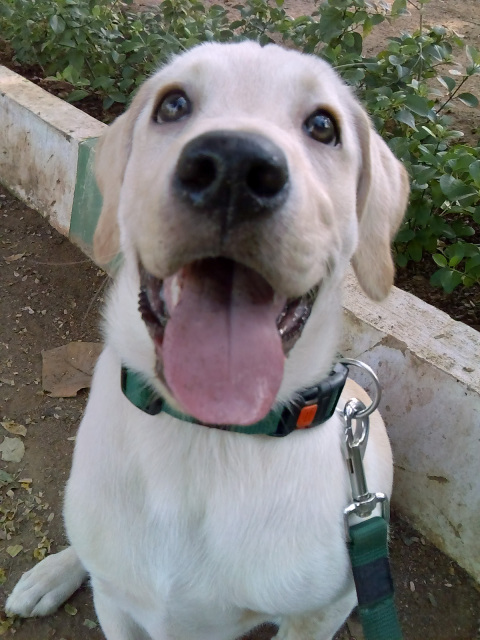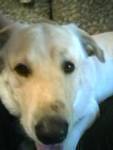QuestionShe is on Eukanuba now, we will leave on it if there is no difference. I went to the website & she seems to be in good shape. All she gets is the dry food, should she get something in addition?
I can see the value of starting with the crate as a puppy, she does not want to go in the crate at all. When inside and not watched she is kept in a small area in front of the washer and dryer, she has yet to have an accident there though. Does that act like a crate?
We do have a trainer coming to start working with her this weekend, but should I force her into the crate now?
Thanks again for all of your help.
-------------------------
Followup To
Question -
We just adopted a 3 year old chocolate lab. She came from a recently divorced couple with 2 children. She is spayed and well-kept, but has absolutely no training.
We would like to switch her to Nutro after a month or so, figure she has enough stress w/o changing food. We have heard to feed her 3 cups daily. I would like to give half in am & rest in evening. Does that sound like enough or to much?
Also have been told the best way to house train is to use crate. Any suggestions?
She has learned to walk on leash after 30 mins, very eager to please.
Thank you for your help.
Answer -
What are you feeding now? Chances are whatever it is, she will do as well on it as Nutro. If you do switch, do so gradually over about a week and stick to the same meat source if you can. Three cups may be about right. The amount needs to be based on her body condition. Here is a link to a great guide, http://www.puppychow.com/products/popup_body_condition.aspx
Some day I am going to rewrite my young puppy housebreaking advice to adapt it to the timing for older dogs.
Housebreaking starts before you get home with the new puppy. If you don't have
a crate, buy one. I prefer the more enclosed, den like plastic ones. Skip the
bedding. At first it gets wet, and later it can be chewed into choking
hazards. A wire rack in the bottom will help keep the puppy up out of
accidents at first. They are available with the crates, but a piece of closely
spaced wire closet shelving from a home supply place is cheaper. If you
already have a metal crate, covering it may help. Just make sure you use
something the puppy can't pull in and chew. Dogs that start out in crates as
little puppies, accept them very well. Never leave an unattended puppy loose
in the house. If nobody can watch it, put it in the crate. I suggest letting
the dog have its crate all its life.
Choose a command and spot you want it to use. The less accessible to strays,
the less chance of serious disease. If it is a female, choosing a
non grassy spot will avoid brown spots later. When you bring it home, take it
to the spot and give it the command in a firm, but friendly voice. Keep
repeating the command and let the puppy sniff around. If it does anything,
praise it. Really let it know what a good dog it is and how much you love it,
and maybe a treat. Note, being out there not only means you can praise it,
but it also keeps it from being snatched by a hawk. If it doesn't go, take it
inside and give it a drink and any meals scheduled. A young puppy will need to
go out immediately afterward. Go to the spot and follow the above routine.
Praising it if it goes is extremely important. If it doesn't go, take it back
inside and put it in its crate and try again soon. Do not let it loose in the
house until it does go.
At first it is your responsibility to know and take the puppy out when it
needs to go. It needs to go out the first thing in the morning, after eating,
drinking, and sleeping. If it quits playing, and starts running around
sniffing, it is looking for a place to go. Take it out quickly. You will just
have to be what I call puppy broke until it is a little older.
By the time most dogs are about 3 months old, they have figured out that if
they go to the door and stand, you will let them out. The praise slowly shifts
to going to the door. Some people hang a bell there for the dog to paw. If
your dog doesn't figure this out, try praising it and putting it out if it
even gets near the door. A stern "Bad dog!" is all the punishment that is
effective, and only when you catch it in the act and are sure you didn't miss
it going to the door. Clean up accidents promptly. I mostly keep the little
puppies out of the carpeted rooms. Still I need the can of carpet foam
sometimes. First blot up all the urine you can with a dry towel. Keep moving
it and stepping on it until a fresh area stays dry. A couple big putty knives
work well on bowel movements. Just slide one under it while holding it with
the other. This gets it up with a minimum of pushing it down into the carpet.
This works with even relatively soft ones, vomit, dirt from over turned house
plants, or anything else from solids to thick liquids. Finish up with a good
shot of carpet foam. Note, do not let the puppy lick up the carpet foam.
Once the dog is reliably housebroken, your carpet may need a good steam cleaning.
Many people strongly strongly push cleaning up all evidence of past accidents. I am slower to suggest that. Dogs will return to the same spot if they can find it. When you see one sniffing the spot, that is your clue to run it out.
AnswerGlad to here you are keeping her lean. Eukanuba is as good as anything. In fact, we are getting our second puppy to raise for a service dog school and they feed their highly valuable dogs Eukanuba. I am familiar with a number of service and dog guide schools. All of them feed an ordinary dog chow such as Eukanuba. None of them feed Nutro or other super premium chows. Nor do they add anything to the chow.
Don't force her into a crate. Entice her into it as I suggested. And yes crates are better than the laundry.
The "shut the puppy in a safe room" is a fallacy. Very few houses even have a
safe room. How many of us have a room with a hard surfaced floor and nothing
else? Most rooms have electrical cords to chew if nothing else. In addition
to destroying anything a bored puppy finds to chew, it may choke or have
intestinal blockage from the pieces. I had a friend that left her dog in a
"safe" room. It ate a hole in the floor covering. The safe rooms fail to
give the dog the comfort of the enclosed space their instinct requires. Nor
do they restrict activity extending the time the dog can go without relieving
itself. Actually many
dogs settle down a little by 3 years old and are not the
terribel chewers I know
so well.
Make sure the trainer is going to train you to be be top dog or leader, not just to bribe her with treats. Limited use of treats is OK.

 Young pup drinks too much
Question
Hi, Im Roxy & I have
I recently adopted a
Young pup drinks too much
Question
Hi, Im Roxy & I have
I recently adopted a
 Lab eating my house! (and everything else)
Question
Pepper
I have a sweet sweet black female lab t
Lab eating my house! (and everything else)
Question
Pepper
I have a sweet sweet black female lab t
 Black Lab age/weight concern
Question
Okimasu
I have a black lab mix. He has a small
Black Lab age/weight concern
Question
Okimasu
I have a black lab mix. He has a small
 Hyper active Labrador Pupp.
Question
Benji
Hello Jen,
&nbs
Hyper active Labrador Pupp.
Question
Benji
Hello Jen,
&nbs
 sniffing female owner
Question
Jack
Hello, thank you so much for taking the t
sniffing female owner
Question
Jack
Hello, thank you so much for taking the t